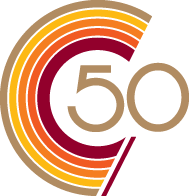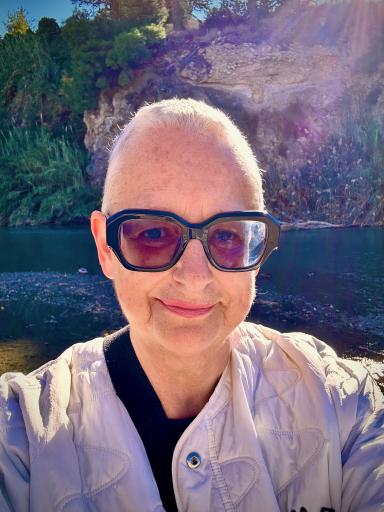
Juliana España Keller, PhD, Arts and Philosophy
- Professor, IMCA (Intermedia & CyberArts), Studio Arts
- Professor, Department of Painting and Drawing, Studio Arts
- Lecturer, ARTT (Art Theory & Academic Discourse), Studio Arts
- Professor/Lecturer, MFA Graduate Program: Deep Listening Practices, Studio Arts
- Senior Researcher and Writer, Centre for Sensory Studies
Status: Pronouns: she/her/elle
Are you the profile owner?
Sign in to editResearch areas: Feminist New Materialism, Posthumanities, Posthuman Knowledge, Social Sciences & Visual Arts Critical Theory
Contact information
Biography
Areas of Expertise
areas of expertise: sound performance and electronic arts,
modular synthesis, performance art practices, intermedia & immersive sound and interactive media. deep listening practices.
research topics: Feminist New Materialism, Posthumanism, Critical Posthumanities, Environmental Humanities.
keywords:
making kin, the posthuman, critical posthuman knowledges, the environmental humanities, the capitalocene, eco-feminist & intersectional theory, social engagement, public spatial practices, visual arts and all forms of experimental sonic art practices.
Research interests
In an age in which we are increasingly conscious of planetary intra-connections –
on environmental, social and biological levels to name just a few –
and in a world increasingly divided on political and economic levels,
how do we communicate across borders and boundaries and give voice to communities?
Small actions create big effects, interdisciplinary interaction,
transdisciplinary practice/s that move away from systems of power that are vaster than any one individual.
How, perhaps might we maintain a sense of agency within this paradigm?
How might we tell stories about these vast systems? And what kind of planetary stories should we tell?
Juliana’s practice-led research is built on a relational architecture of iterative sound performances that position the art historical, the sociopolitical, transforming disciplinary interpretations of the body and technology as something that is not specifically exclusively human but post-human. Juliana speaks through a creative practice that unfolds as a sharing of experiences through these propositions. She also channels the intra-personal; through the entanglement of her own personal cultural experience and diverse background, where language, meaning and subjectivity is relational to what it means to be human and to what is felt from the social, what has informed her from a multi-cultural nomadic existence and perspective.
Through the medium of sound, Juliana investigates and emphasizes entities, ethics, social class and social political intervention in the process. This subjectivity illuminates how we move through the world, react to surroundings and respond to everything. It also proposes how the normative and hierarchical relations amongst human groups based on race, sexuality, social class and ability are always intimately entangled with the broader political and posthuman economies/ecologies of which we are a part.
The performance work establishes a scaffold for thinking about a range of ideas of what is felt through encounters with philosophy, sonic arts, feminist and posthuman thought. It highlights labored bodies entangled with posthuman contingencies of food preparation, family and social history, ritual, tradition, social geography, local politics and women’s oppression. The human and non-human relation to machines and machine learning is enacted through intra-active entanglement; it represents an active pedagogy practice for organising and responding collectively to, the local.
A noisy kitchen is felt as a musical sounding in the everyday rhythm of lived intensities. Agency is conjured through the doing-cooking of the kitchen to create a sonic recipe as the becoming of the human-machine relationship to uncover the paradigms that shape-shift performance, cross-fertilizing with technology and futurities of social robotics by finding ways forward in untangling the discourse surrounding robotic machines, humanoids and AI.
In particular, it considers how feminist new materialism can be “put to work”, creating daring dissonant narratives that feed posthuman ethical practices and feminist genealogies. Juliana’s research reveals what matters—a feminist struggle invaluable in highlighting and responding collectively to the local with a systemic understanding material phenomena in an immersive sonic performative installation. Her research practice proposes to ignite and transform our social imagination and deactivate pervasive and dominating patriarchal ethico-politics and to decolonize as well as dismantle colonial perspectives and pedagogies.
Education
PhD, Arts and Philosophy, The Victorian College of the Arts,
The University of Melbourne, Victoria, Australia (2015 – 2020).
MFA, Sculpture, Studio Arts, Concordia University (2000 - 2003).
BFA, Painting & Drawing, Studio Arts, Concordia University (1997 - 2000).
Biography
Dr. Juliana España Keller is a British/Canadian/Swiss Sound and Performance Artist, Curator, Researcher/Writer and Educator living and working between Montréal, Quebec and Alhaurín el Grande (Malaga) Andalucía, Spain.
Juliana's practice-led research transgresses how geographic places are experienced, emphasizing transformation pedagogically, as a feminist new materialist politic of connection in a posthuman world. Juliana sees this platform as a model of transdisciplinary inquiry for art and social action. Juliana's practice-based artwork explores how complex social, economic and ecological systems can operate in ways that diffuse distinctions between fiction and reality, or nature and culture.
Listening deeply to collective intelligence, (non-human intelligences, animal, plant life and microbial intelligence), the artist explores the transformations of the human, the more-than-human, the future of labour and creativity in a posthuman world. Keller's work has been featured in both group and solo exhibitions around the world and locally in Quebec.
Juliana creates radical entanglements with modular synthesis in sound art through speculative research. Juliana is interested in fluctuating sites with sensing subjects and tactile experimentation within participatory practices.
"capturing sound as a practice of sensing"
"we are in the world and the world is in us"
In her feminist new materialist practice, she uses simple electronic processes to observe different materialities of sound. She places electronic components which includes sensory stimuli in different situations of intra-action with the body. She experiments with organic materials, kitchen tools and appliances, and environmental stimuli. From these collisions, synthesized sounds emerge to create collaborative narrations or sonic recipes and observations that she observes as radical entanglements in the natural world.
Juliana is a member of “The Sense Lab:3 Ecologies Institute” in Montreal, Canada. “PhEMaterialisms Group” in the UK, led by Dr. Jane Osgood, “Mapping FutureImaginaries”, in Melbourne, Australia led by Dr. Linda Knight at RMIT University in Melbourne, Australia.
Juliana has performed locally at The Phi Centre, MACM (Museum of Contemporary Art Museum of Montreal), The MAC LAU (Contemporary Art Museum of the Laurentians), the CCA (Canadian Centre for Architecture in Montreal, Canada) with WWKA (Women with Kitchen Appliances), ISEA (International Symposium on Electronic Arts, Barcelona, Dubai (U.A.E.), Hong Kong (China), Centro Negra AADK (Murcia, Spain), Mengi (Reykjavik, Iceland), SIM (Samband íslenskra mynlistarmanna), Berlin, Germany, Glasshouse ArtLab (Brooklyn, New York), Muu Gallery (Helsinki, Finland), 300m2 (Gothenburg, Sweden), Nina Menocal Gallery (Mexico City, Mexico), BrickFactory Studioworks (Hobart, Tasmania).
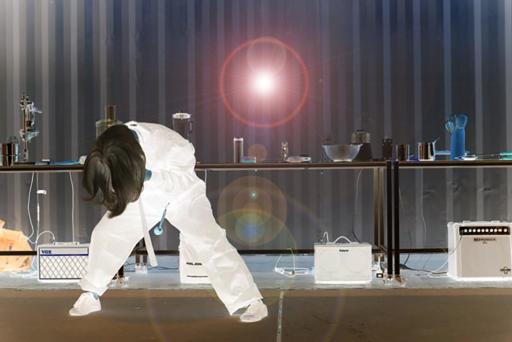
sonic electric melbourne (2017)
©jonathan sinatra
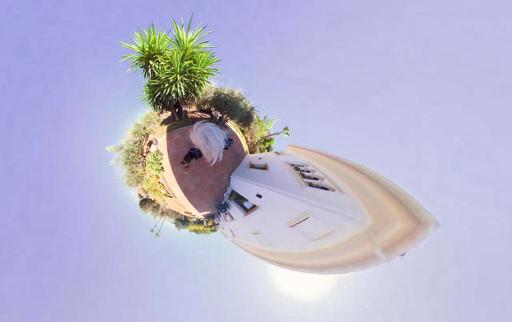
(360) Video: Bajo El Olivo
Juliana Espana Keller
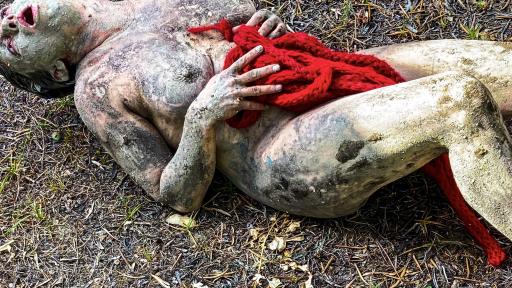
becoming compost
©julianaespanakeller
Publications
Entering Into a Sonic Intra-Active Quantum Relation with Plant Life
In the speculative research of plant bioacoustics, one enters into a sonic intra-active relation, by humans with non-human beings (plant life), activated through acoustic wave signals emitted by plants to create electronic patterns of sounds composed by humans and emitted by machines. Plants emit sound waves at relatively low frequencies of 50-120 Hz. Experimenting with patching and modulation by tracking these sonic lines of data can indeed lead to unique sonic experiences that tap into the universe’s musicology. It is fascinating how we can interact with sounds on such a deep level to create acoustic energy.
We are and have always been attached to the universe in a relational processual way. We are all interconnected with plant life vibrating at different internal frequencies. This article focuses on a symbiotic relation between humans and plant life as an acoustic shimmering ecologyto communicate a posthuman, symbiotic understanding of vegetal matter as a morphological force that (re)shapes, (re)affirms our sonic intra-relations to the natural world. This proposition is molecular and metaphysical, as sound matter is of a qualitative multiplicity in the quantum field of listening. By acknowledging ontologically that cosmopolitics brings into relation different practices, practitioners, and the non-human (they assemble in a field of forces and intensities), I argue that there is no sovereign power under which all modes of existence can be organized, and there is no metalanguage through which one can master the diversity of all discursive or material practices; but there are intra-relations in which one can get lost in a quantum field of sonic matter by moving into the cracks of the sensorium and the plant biosphere, which includes Indigenous voices.
The alterity of plant life is daunting from an eco-feminist materialist position in that relationships are the default state of existence and sonic experiences uncover alternative or additional explanations in a (post)phenomenological world which is embedded in the stuff of acoustics in the many ways humans hear the world. Thus, to communicate a posthuman, symbiotic understanding of vegetal matter necessitates understanding how sound matter intra-performs through a sonic language where intra-relations with plant life have complex boundaries for humans. As a creative practitioner, how does one define the mutually beneficial engagement in plant communication with creative musical encounters? Entanglement is messy and a becoming with the universe as a philosophical sonic meditation and worlding. This entails expanding on plants as cosmogonic beings, world builders, and we, perhaps, are the byproducts of the lives of our vegetal others.
Book Review: Musical Encounters with Deleuze and Guattari. New Materialism. The mattering of the arts, crafts, and aesthetics. The Polish Journal of Aesthetics. Nr. 57 (2/2020)
This book review discusses the volume: Musical Encounters with Deleuze and Guattari (2017), edited by Pirkko Moisala, Taru Leppänen, Milla Tiainen, and Hanna Väätäinen. This polyphonic title concentrates on Deleuzian-Guattarian research as well as elaborations on Spinozian metaphysics. The book’s multisensory expanse of subjects in feminist new materialisms encompasses, among others, music and sound studies, expanded listening, dance, dis/ability, semiotics, and ethnography. The work provides vital attention to concepts such as affect, becoming, and assemblages, including different ways of moving and conceiving across contemporary creative practices.
https://pjaesthetics.uj.edu.pl/pl_PL/archives/-/journal_content/56_INSTANCE_r1lnMup4DOPq/138618288/146139866
The Sonic Intra-face of a Noisy Feminist Kitchen
This paper asks what is the value of transforming the kitchen into a sonic performative work and public site for art and social practice. A Public Kitchen is formed by recreating the private and
https://www.mdpi.com/2076-0760/8/9/245
GRETA//A PLASTIC POEM: An Integrated Approach to the Vibrant Matter of Voice, Deep Listening, and Somatic Movement in Sonic Performance Art as Plastic Activism
Through an analysis of the sonic performance artwork GRETA//A PLASTIC POEM (2020), this paper analyzes why and when participatory art practices can intra-sect and converge with ecologies to imagine posthuman futures and challenge pre-existing structures of thought. From an activist position that considers art and the environment as a participatory collective model, this article argues for a reappraisal of human influence in complex human-non-human interactional systems. More specifically, this text, as a component of GRETA//A PLASTIC POEM, approaches oceanic and sea pollution (notably the dumping of plastics) as a form of environmental degradation that has generated a space inhabited by varied and vibrant forms of matter. In this way, the sea and the sonic space show strikingly similar potentials. In turn, Plastic Activism, which advocates for a world free of plastic pollution and its toxic impacts, is adopted as an underlying ethos and aesthetic response, with single-use plastics being incorporated into the performance artwork itself. Relational to this enquiry is sensing how we use our bodies to explore the potential thousands of distinct material ecologies embodying a sonic performative practice, especially combining the materiality of artistic and political action in public space and focal practices. In this way, the sonic space becomes comparable to a sea of sound, where complex assemblages of matter exist and intra-act to challenge the discordant systems and dynamics in which we are currently entangled.
Teaching activities
IMCA 210 (Introduction to Video Production)
IMCA 332 (Performance Art Practices & Video Performance Production)
IMCA 400 (Advanced Practices in Intermedia & Cyber Art)
ARTT 398 (Topics/Studio Practice: Ideas and Issues, Artistic Praxis & Language)
ASEM 652 (Deep Listening Practices Seminar) MFA Program.


